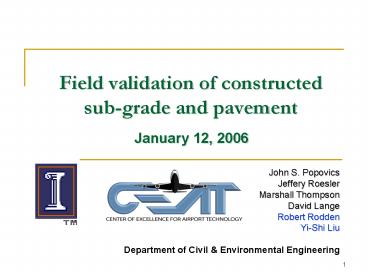Field validation of constructed sub-grade and pavement
1 / 18
Title: Field validation of constructed sub-grade and pavement
1
Field validation of constructed sub-grade and
pavement
January 12, 2006
- John S. Popovics
- Jeffery Roesler
- Marshall Thompson
- David Lange
- Robert Rodden
- Yi-Shi Liu
- Department of Civil Environmental Engineering
2
Pavement structure
1
2
3
4
5
Sequential access to individual layers is needed
3
Tasks
- Structural response testing and analysis
- Pavement layer thickness determination
- Bulk material sampling
- Concrete pavement instrumentation
4
Structural response testing and analysis
Field tests to determine structural
response/stiffness will be carried out by the
designated engineering consultant (e.g. APTech)
on appropriate layers.
- Falling weight deflectometer (FWD)
- Light-weight FWD
- Dynamic cone penetrometer (DCP)
Pavement layers 1-4
Pavement layers 4 and 5
Pavement layers 4 and 5
5
Pavement layer thickness determination
Nondestructive tests to determine in place
thickness of bound layers will be carried out by
UIUC team so to optimize layer property
back-computation process.
- Impact-echo (IE) and seismic methods
- Surface wave methods (SASW and MASW)
Pavement layer 1
Pavement layers 1-3
6
Asphalt material sampling
Material samples from asphalt-bound layers (2 and
3) will be gathered during construction. Dynamic
stiffness and stability properties will be
determined through laboratory tests.
Work carried out in collaboration with Professors
Buttlar and Al-Qadi.
7
Concrete pavement instrumentation
Validate performance of constructed
pavements with respect to environmental and
mechanical loads. Data collected from sensors
embedded in concrete slab (layer 1)
- Relative humidity (RH) and temperature
- Slab lift-off
- Joint opening
8
Relative humidity/temp sensors
- Sensirion SHT75
- Single sensor measures RH and Temperature
- RH accuracy /- 1.8
- Temp accuracy /- 0.3
- Sample at depths 1, 4, 7.5, 11, and 14 for
complete profile - Sensors used and proven reliable by UIUC
9
Slab lift-off gauges
- Two possible solutions
- Modified LVDT
- Tip fixed to asphalt
- LVDT mounted in chamber that is bonded to
concrete - Used by FAA RD Division (NAPTF)
- Non-Contact DVRT
- Senses distance relative to metal target without
contact - Widely used for structural deflections
- Resolution for both
- 1.0-2.0 microns
10
Joint opening gauges
- Surface-mounted LVDTs
- LVDT and reaction platen fixed to the top of slab
across joint near edge - Resolution 1.0-2.0 microns
11
Additional sensor possibilities
- Additional instrumentation may be included if
channels available - Concrete strain gauges
- Ideally sample 1, 4, 7.5, 11, and 14 from
surface at edge and center in 2 directions - Provides strain for modeling purposes
- Instrumented Dowel Bars
- Provides shear/bending at joints
12
Data loggers multiplexers
- Battery-powered datalogger developed at UIUC
(Campbell Scientific) - Plan to build a new 22-channel datalogger for
OHare tests - Sensor multiplexer used and proven reliable by
UIUC
13
Proposed sensor layout (plan view)
14
Past pavement sensing experience at UIUC
- In October 2005
- Cast 3 slabs (Plain, Cured, and SRA PCC) at ATREL
- Utilized a 55 channel computer-independent
datalogger - Cast 3 representative cubes which were placed in
a 50 RH chamber - Utilized a 30 channel datalogger
- Collected RH/Temp data at various locations
above, at the surface, and through the depth of
all slabs/cubes for two months continuously
15
Field system validation
- 5 positions in each slab were replicated to
illustrate the reliability of the system - Excellent reliability and repeatability as shown
below
16
New surface sampling technique
- Novel surface measuring technique developed at
the UIUC was successful
17
Summary
- Field verification of constructed subgrade and
pavement layers will be carried out by a
complementary set of field tests (tasks 1 and 2),
laboratory tests (task 3) and in-place sensing
(task 4). - Field tests to be carried out on individual
exposed pavement layers. - Sensing continued over time to monitor effects of
environmental and structural loads.
18
Coordination issues
- Establish point of contact for field work
- Establish location of slabs, sensors and
dataloggers - Establish dates of construction to enable access
to individual layers - Establish logistics of access for installation
and data collection






























